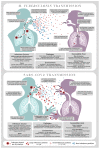Mycobacterium tuberculosis Transmission in High-Incidence Settings-New Paradigms and Insights
- PMID: 36364978
- PMCID: PMC9695830
- DOI: 10.3390/pathogens11111228
Mycobacterium tuberculosis Transmission in High-Incidence Settings-New Paradigms and Insights
Abstract
Tuberculosis has affected humankind for thousands of years, but a deeper understanding of its cause and transmission only arose after Robert Koch discovered Mycobacterium tuberculosis in 1882. Valuable insight has been gained since, but the accumulation of knowledge has been frustratingly slow and incomplete for a pathogen that remains the number one infectious disease killer on the planet. Contrast that to the rapid progress that has been made in our understanding SARS-CoV-2 (the cause of COVID-19) aerobiology and transmission. In this Review, we discuss important historical and contemporary insights into M. tuberculosis transmission. Historical insights describing the principles of aerosol transmission, as well as relevant pathogen, host and environment factors are described. Furthermore, novel insights into asymptomatic and subclinical tuberculosis, and the potential role this may play in population-level transmission is discussed. Progress towards understanding the full spectrum of M. tuberculosis transmission in high-burden settings has been hampered by sub-optimal diagnostic tools, limited basic science exploration and inadequate study designs. We propose that, as a tuberculosis field, we must learn from and capitalize on the novel insights and methods that have been developed to investigate SARS-CoV-2 transmission to limit ongoing tuberculosis transmission, which sustains the global pandemic.
Keywords: COVID-19; TB; high-incidence; mycobacterium tuberculosis; transmission.
Conflict of interest statement
No conflict of interest to declare.
Figures
References
Publication types
Grants and funding
- RIA2018D-2493/European Union
- 1K01AI156022-01/NH/NIH HHS/United States
- U54 EB027049/EB/NIBIB NIH HHS/United States
- RIA2020I-3305/European Union
- U54EB027049/NH/NIH HHS/United States
- D43TW010350/NH/NIH HHS/United States
- R01AI136894/NH/NIH HHS/United States
- U01 AI152087/AI/NIAID NIH HHS/United States
- D43 TW010350/TW/FIC NIH HHS/United States
- U01AI152087/NH/NIH HHS/United States
- RIA2018D-2509/European Union
- K01 AI156022/AI/NIAID NIH HHS/United States
- R01 AI136894/AI/NIAID NIH HHS/United States
- APP1200755/Medical Research Future Fund
LinkOut - more resources
Full Text Sources
Miscellaneous



